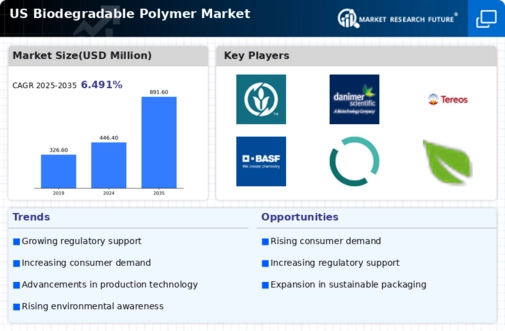The biodegradable polymer market is currently characterized by a dynamic competitive landscape, driven by increasing environmental awareness and regulatory pressures. Key players are actively pursuing strategies that emphasize innovation, sustainability, and regional expansion. For instance, BASF SE (Germany) has been focusing on enhancing its product portfolio through research and development, aiming to introduce more advanced biodegradable solutions. NatureWorks LLC (US) is strategically positioned as a leader in the production of polylactic acid (PLA), leveraging its strong supply chain to meet growing demand. Meanwhile, Novamont S.p.A. (Italy) emphasizes its commitment to sustainability by integrating circular economy principles into its operations, which enhances its competitive edge. Collectively, these strategies contribute to a moderately fragmented market structure, where innovation and sustainability are pivotal in shaping competitive dynamics.
In terms of business tactics, companies are increasingly localizing manufacturing to reduce carbon footprints and optimize supply chains. This approach not only enhances operational efficiency but also aligns with consumer preferences for locally sourced products. The competitive structure of the market remains moderately fragmented, with several key players influencing trends and driving growth through strategic initiatives. The collective influence of these companies fosters a competitive environment where differentiation is achieved through innovation and sustainability rather than solely on price.
In October 2025, BASF SE (Germany) announced a partnership with a leading agricultural firm to develop biodegradable films for crop protection. This strategic move is significant as it not only expands BASF's product offerings but also aligns with the growing demand for sustainable agricultural practices. The collaboration is expected to enhance the company's market presence and reinforce its commitment to sustainability in the agricultural sector.
In September 2025, NatureWorks LLC (US) launched a new line of biodegradable packaging solutions aimed at the food service industry. This initiative is crucial as it addresses the increasing consumer demand for eco-friendly packaging options. By diversifying its product range, NatureWorks is likely to strengthen its market position and cater to a broader customer base, thereby enhancing its competitive advantage.
In August 2025, Novamont S.p.A. (Italy) unveiled a new bioplastic derived from renewable resources, aimed at reducing plastic waste in urban environments. This development is particularly relevant as it underscores the company's commitment to innovation and sustainability. By introducing products that directly address environmental concerns, Novamont is poised to capture a larger share of the market and reinforce its leadership in the biodegradable sector.
As of November 2025, current trends in the biodegradable polymer market are increasingly defined by digitalization, sustainability, and the integration of advanced technologies such as AI. Strategic alliances among key players are shaping the competitive landscape, fostering innovation and enhancing supply chain reliability. Looking ahead, it appears that competitive differentiation will evolve, with a notable shift from price-based competition to a focus on innovation, technology, and sustainable practices. This transition suggests that companies that prioritize these elements are likely to thrive in the evolving market.

















Leave a Comment